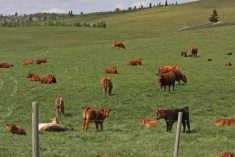INNISFAIL, Alta. – A bad experience with ostriches was instrumental in introducing the Gislers to goats.
The family was looking for something unique to raise on its central Alberta farm after selling the dairy herd and was intrigued by ostriches.
However, the two pairs they bought lasted only two weeks.
“They were miserable. We got rid of them quick,” said Merna Gisler, who raises goats with her parents, Pam and Vern, and uncle, Ernie.
The family then looked for more personable animals and fell in love with Boer goats.
Read Also

Trump’s tariffs take their toll on U.S. producers
U.S. farmers say Trump’s tariffs have been devastating for growers in that country.
“I just love them. I could stay out here all day,” said Gisler, standing in a pen of does and newborn kids bouncing off rocks and each other.
Vern and Ernie bought two does at Olds College’s first Boer goat sale in 1994.
They reminded Vern of the goats on the Alps of his native Switzerland. They were also something unique, and the family could see a future in raising them.
The family has used embryo transfer and good quality bucks over the past 17 years to improve the purebred herd, winning numerous shows and competitions.
“The does we bought in 1994 aren’t near the quality we have now,” said Gisler, who has three purebred flocks, including the traditional red and white, solid red and black.
“I try to raise good breeding stock and encourage the development of the breed in Canada,” she said.
The number of goat shows and fairs has slowly diminished over the years.
Goat associations have responded by hiring judges to travel to farms and give breeders tips on the ideal goat.
Gisler said it’s an inexpensive way for goat breeders to improve the quality of their animals.
New producers have also demanded more information on nutrition, health and production basics.
The Alberta association has 200 members, the largest since BSE played havoc with the industry in 2003.
“We’re becoming more recognized with government and more legitimate, not just a backyard industry,” she said.
Goats have moved over the past 15 years from the backyards of hippies to the corrals of mainstream producers who can’t keep up with the demand for goat meat, milk and fibre.
Gisler, who is president of the Alberta Goat Breeders Association, expects interest in goats to remain high as Canada’s ethnic population increases. Canada imports about 98 percent of the goat meat consumed domestically.
“The Alberta goat population wouldn’t support Calgary for a week- end. We wouldn’t make it through half of Ramadan,” she said, referring to the Islamic month of fasting.
“The Islamic market wants fresh and are willing to pay for it. The demand for goat products is high.”
As a single woman, Gisler believes her 90 does and their offspring are about the ideal number for one person.
“I promote it as ideal for women and they can still live on the farm. A woman can do this on her own.”
Gisler said she almost killed her goats with kindness when she first started raising them. She treated them like babies and fat mothers had difficulty kidding.
The goats must now leave the barn for food, water and exercise, regardless of the temperature.
“They are an independent animals and don’t need to be babied,” she said.
———
access=subscriber section=farmliving, none, none














